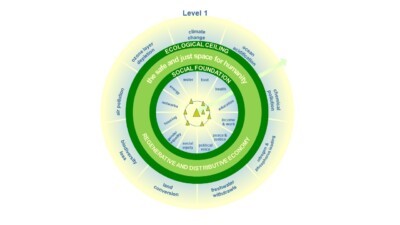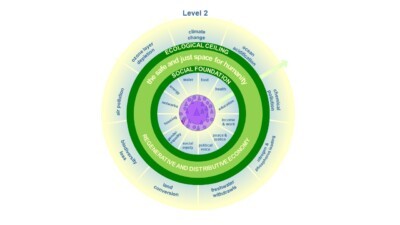Thought Experiment 2 Egocentric Worldview: Spiral Dynamics, Integral City & Doughnut Economics
We continue our Thought Experiment in this instalment by looking at Doughnut Economics (DE) and its relationship to Spiral Dynamics and Integral City through an Egocentric Worldview.

As we noted in our first blog, the Egocentric Worldview spans Levels 1 and 2 in Spiral Dynamics (see Table 2). An egocentric worldview embraces the structures of Family Hearth and Clan Gathering.
Table 2: Egocentric Worldview, Spiral Dynamics, Archetypal Structure
WorldviewSpiral Dynamics Level of ComplexitySpiral Dynamics ExpressionArchetypal StructureEgocentricLevel 1Beige – IndividualFamily HearthLevel 2Purple – CollectiveClan GatheringWe can summarize the inner qualities and outer contexts of these 2 levels complexity as set out in Figures 3 and 4.
Figure 3

Figure 4

As we are examining the correlative life conditions that Doughnut Economics points to, we can imagine historically, that the inner and outer factors of DE live within the balance of the Ecological Ceiling and Social Justice factors. Historically, the kinds of human settlements that emerged at these stages were indigenous habitations living in balance with the local life conditions.
At the first level of complexity, DE Inner factors included energy (biofuel), food, water, health. Outer factors included air, oceans, climate.
The Level 1/Beige Spiral Dynamic factors were oriented to the individual with the focus on survival, and garnering the basics of life for energy, food, water and health. The Human System Context that set the life conditions at this level of complexity were family, foraging/gathering, responding to land, water, air and geology.
At the second level of complexity, DE Inner factors expanded from the first level’s factors to include housing and gender equity as human systems became more complex. Outer factors expanded to include fresh water, land, biodiversity.
The Level 2/Purple Spiral Dynamic factors are oriented to the collective with the worldview still egocentric but expanded to the clan. In this 2nd level of complexity resources became shared for energy, food, water, health and housing. The Human System Context that set the life conditions at this level of complexity were clan, respecting clan elders, foraging/gathering in groups, worshiping spirits of land, water, air.
Thus, DE helps to situate the emergence of Social Justice factors at the early stages of human history when the Ecological Ceiling was not threatened (not only because of the simple way of living, but because human populations remained low and spread across wide areas of the globe.
Looking at human habitations in 21st century we can consider the implications that worldviews and capacities have on the effectiveness of economies that cannot yet express a full set of Social and Justice factors. We can also be cognizant of the reduced availability of Ecological resources for such human settlements because of the incursions of more complex human systems, not living within the Ecological Ceilings and/or ignoring Social Justice factors for all people.
This series of Thought Experiments consider: How do the Spiral Dynamics integral worldviews of humans living in cities impact the Social Justice and Ecological Ceiling dimensions represented in Doughnut Economics? The blog series includes the following:
Integral City Thought Experiment 1: Exploring Doughnut Economics & Spiral DynamicsThought Experiment 2 Egocentric Worldview: Spiral Dynamics, Integral City & Doughnut EconomicsThought Experiment 3 Ethnocentric Worldview: Spiral Dynamics, Integral City & Doughnut EconomicsThought Experiment 4 Regionalcentric Worldview: Spiral Dynamics, Integral City & Doughnut EconomicsThought Experiment 5 Globalcentric Worldview: Spiral Dynamics, Integral City & Doughnut EconomicsMarilyn Hamilton's Blog
- Marilyn Hamilton's profile
- 3 followers



